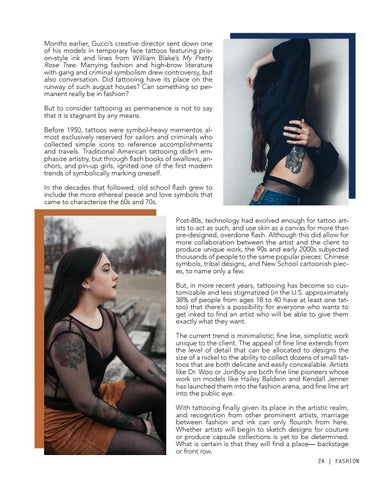Months earlier, Gucci’s creative director sent down one of his models in temporary face tattoos featuring prison-style ink and lines from William Blake’s My Pretty Rose Tree. Marrying fashion and high-brow literature with gang and criminal symbolism drew controversy, but also conversation. Did tattooing have its place on the runway of such august houses? Can something so permanent really be in fashion? But to consider tattooing as permanence is not to say that it is stagnant by any means. Before 1950, tattoos were symbol-heavy mementos almost exclusively reserved for sailors and criminals who collected simple icons to reference accomplishments and travels. Traditional American tattooing didn’t emphasize artistry, but through flash books of swallows, anchors, and pin-up girls, ignited one of the first modern trends of symbolically marking oneself. In the decades that followed, old school flash grew to include the more ethereal peace and love symbols that came to characterize the 60s and 70s. Post-80s, technology had evolved enough for tattoo artists to act as such, and use skin as a canvas for more than pre-designed, overdone flash. Although this did allow for more collaboration between the artist and the client to produce unique work, the 90s and early 2000s subjected thousands of people to the same popular pieces: Chinese symbols, tribal designs, and New School cartoonish pieces, to name only a few. But, in more recent years, tattooing has become so customizable and less stigmatized (in the U.S. approximately 38% of people from ages 18 to 40 have at least one tattoo) that there’s a possibility for everyone who wants to get inked to find an artist who will be able to give them exactly what they want. The current trend is minimalistic; fine line, simplistic work unique to the client. The appeal of fine line extends from the level of detail that can be allocated to designs the size of a nickel to the ability to collect dozens of small tattoos that are both delicate and easily concealable. Artists like Dr. Woo or JonBoy are both fine line pioneers whose work on models like Hailey Baldwin and Kendall Jenner has launched them into the fashion arena, and fine line art into the public eye. With tattooing finally given its place in the artistic realm, and recognition from other prominent artists, marriage between fashion and ink can only flourish from here. Whether artists will begin to sketch designs for couture or produce capsule collections is yet to be determined. What is certain is that they will find a place— backstage or front row. 24 | FASHION
Issuu converts static files into: digital portfolios, online yearbooks, online catalogs, digital photo albums and more. Sign up and create your flipbook.



















